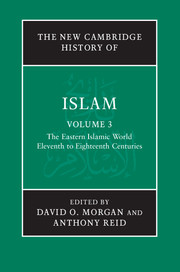Book contents
- Frontmatter
- Introduction: Islam in a plural Asia
- PART I THE IMPACT OF THE STEPPE PEOPLES
- PART II THE GUNPOWDER EMPIRES
- PART III THE MARITIME OECUMENE
- 9 Islamic trade, shipping, port-states and merchant communities in the Indian Ocean, seventh to sixteenth centuries
- 10 Early Muslim expansion in South-East Asia, eighth to fifteenth centuries
- 11 Follow the white camel: Islam in China to 1800
- 12 Islam in South-East Asia and the Indian Ocean littoral, 1500–1800: expansion, polarisation, synthesis
- 13 South-East Asian localisations of Islam and participation within a global umma, c. 1500–1800
- 14 Transition: the end of the old order – Iran in the eighteenth century
- PART IV THEMES
- Glossary
- Bibliography
- Index
- References
13 - South-East Asian localisations of Islam and participation within a global umma, c. 1500–1800
from PART III - THE MARITIME OECUMENE
Published online by Cambridge University Press: 28 March 2011
- Frontmatter
- Introduction: Islam in a plural Asia
- PART I THE IMPACT OF THE STEPPE PEOPLES
- PART II THE GUNPOWDER EMPIRES
- PART III THE MARITIME OECUMENE
- 9 Islamic trade, shipping, port-states and merchant communities in the Indian Ocean, seventh to sixteenth centuries
- 10 Early Muslim expansion in South-East Asia, eighth to fifteenth centuries
- 11 Follow the white camel: Islam in China to 1800
- 12 Islam in South-East Asia and the Indian Ocean littoral, 1500–1800: expansion, polarisation, synthesis
- 13 South-East Asian localisations of Islam and participation within a global umma, c. 1500–1800
- 14 Transition: the end of the old order – Iran in the eighteenth century
- PART IV THEMES
- Glossary
- Bibliography
- Index
- References
Summary
Situated as it is in geographic distance from the so-called ‘central lands’ of Islamicate civilisation in the Middle East, South-East Asia has often been regarded by modern scholarship as an ‘exceptional’ case, with discussions tending to focus on issues such as ‘syncretism’. While some of the forms that Islamic thought and practice take in various parts of the region may be distinctive, however, it would be mistaken to assume from this that somehow the religious texts and traditions of the region are necessarily ‘less Islamic’ than those of Muslim societies in the Middle East, or that Islam was merely a ‘thin, flaking veneer’ upon more solid foundations of Indic and local cultures. Often implicit in such views are ahistorical and essentialised understandings of ‘Islam’ conceptualised in relation to a rather limited range of modern reformist conceptions that persist across various academic fields, as well as in popular perceptions.
There are rich traditions of Islamic religious thought and practice throughout South-East Asia, comprising a diverse array of local expressions. Mainland Muslim communities, including Cham, Malay and other ethnic minority populations in what are today the nation states of Vietnam, Cambodia, Thailand and the Philippines have complex histories in which the mutual interaction of Islamicate, Indic and indigenous cultural forms have been dynamically negotiated. However, due to constraints of space, this chapter will focus on developments in the Indonesian archipelago.
- Type
- Chapter
- Information
- The New Cambridge History of Islam , pp. 470 - 503Publisher: Cambridge University PressPrint publication year: 2010
References
- 2
- Cited by



